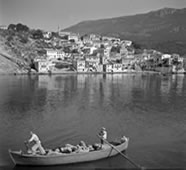 |
Parga Today |
A Venetian castle on the headland over looks the harbour front to the south and the attractive bay of Valtos Beach to the north.
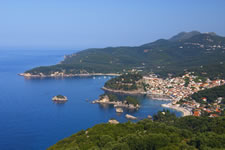
The dramatic and stunning coastline of Parga offers a good variety of beaches for you to choose from daily. If you enjoy snorkelling and diving for shells you can visit some of the small rocky beaches like Piso Krioneri.
If you want to relax on long beaches with sun beds, umbrellas and amenities at hand you can visit Valtos or Lichnos Beach. Or for a quiet day's sunbathing you can travel along the coastline to one of the many secluded coves.
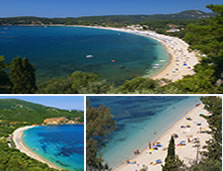
If you enjoy exploring on foot, Parga has a charm that will unfold before you. Old narrow streets of the original village take you back in time and you will see the locals about their daily life.
Heading to the mountain side will lead you into the magical atmosphere of the olive groves and the coastal walks will thrill you with cliff top views.
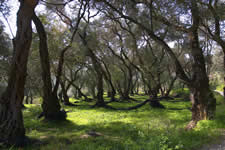
Parga has been popular for many years with Greeks and Italians who visit mainly in August. The charm of this old Greek town has appealed more recently to northern Europeans who enjoy the warmth and hospitality of this lively town that are a constant reminder of the Greek way of life.
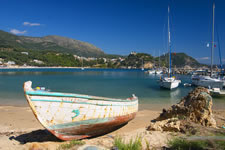
 |
A Visitors Guide to the History of Parga |
The village of Parga , as for much of Greece , has experienced a diverse and turbulent history. To give visitors a brief insight to the background of this fascinating past we have put together major events that have formed Parga's history.
1300's -The Beginnings of a Village called Parga
Although evidence does suggest that in antiquity a town existed in the place of modern day Parga, the first mention of Parga as a settlement is recorded in the Byzantium age in relation to the Venetian Republic of the 13 th century.
It is believed that Byzantine Parga was originally built in the mountains to the east, now known as Paleoparga (literately Old Parga). The move to the coast was made around 1360 both to avoid Albanian invasions and to exploit the fertile land.
In the new coastal position Parga was brought under the protection of the Normans who first built a castle on the headland to protect the village.
1400's - Parga and the Struggle for Mediterranean Dominance
With the constant threat from the Turks, Parga signed in 1401 to become in the alliance and protection of the Republic of Venice.
This treaty continued for four centuries and Parga became an important Epirot town and Pargiotes prospered financially with the cultivation of the olive groves that still surround Parga today. The Venetians fortified the original Norman castle.
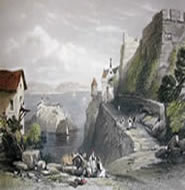
1500's - Unsettled Times
In 1537 as the battle between the two great powers continued, Parga suffered adevastating attack by Barbarossa, who was sent by the Turkish Sultan as retribution for Venetian attacks on Turkish held towns. Parga's castle was destroyed and the town plundered. The Venetians restored the castle and the town of Parga only to have the castle destroyed once again by the Turks in 1571.
The rebuilding of the castle one year later is the remaining structure of the castle you see today.
1700's - A Timely Diversion
Battles fought on Greek soil between the Venetians and the Turks continued through the 18 th century. The safety of Parga was threatened when the Turks lay siege to Corfu in 1716, an army of 30,000 men conquered all but Corfu Town itself which was protected by the walls of the citadel. Before the Turkish troops managed to overcome the citadel they were pulled out of the island for reinforcements elsewhere.
1800's -Parga is Finally Occupied by the Turks
The might of the Ottoman Empire was advancing by land into Epirus led by Ali Pasha who was intent on plans of his own, an independent state for him to govern away from the control of his Sultan.
The mountainous Epirot terrain combined with the fierce resistance of the inhabitants made conquering many of the villages difficult for the Turks. The villages of Souli, 30km north east of Parga, become infamous for the bravery of their fighters and the vast knowledge they had of the mountains. Ali Pasha was constantly enraged by the Pargiotes who gave refuge and supplied weapons to the Souliot fighters who organised attacks against him.
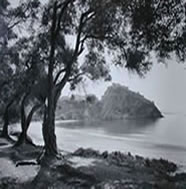
In 1814 Parga's protection changed hands to the British, a move that was to have enormous repercussions in the history of Parga and her people.
However Ali Pasha underestimated the strength of Parga's castle fortress and the resolve of the Pargiotes and he remained unable to conquer the town.
It was not until 1817 when, for an agreed sum of money, the British High Commissioner Thomas Maitland, made a pact with Turkey and passed Parga into the hands of Ali Pasha.

Parga's Exodus
The defiant and proud people of Parga refused to live under the tyranny of Ali Pasha and in 1819 the Pargiotes fled to Corfu taking with them sacred vessels, icons and the ashes of their ancestors that they had previously dug up and burnt.
1800's -Greek Liberation
1930 brought great celebration to Parga when the Greek warship 'Elli', accompanied by the entire Greek fleet brought Parga's sacred possessions back from Corfu .
They are now in the Ecclesiastical Museum of Parga, next to the main church of Agios Nikolaos.
